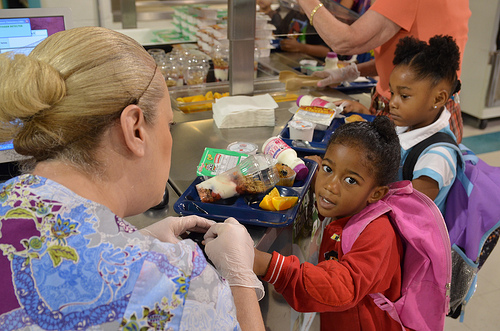
Visitors gather at Bracken Cave near San Antonio, Texas, to experience the nightly flight of millions of Mexican free-tailed bats. A public education webinar is set for Sept. 18. Registration is free. Photo courtesy of: Bat Conservation International
Want to know more about one of the most beneficial, yet misunderstood mammals on earth? Learn more about the amazing life of bats including the home of the world’s largest bat colony as the U.S. Forest Service co-sponsors a live distance learning web broadcast on Sept. 18. Read more »

A seasonal high tunnel, built with assistance from the Natural Resources Conservation Service, helps the Hooks to expand their growing season.
Alphonso (Al) Hooks, a farmer from the Milstead community near Shorter, Ala. has expanded his produce-growing-and-processing operation from a small local concern to also being a supply source for regional Walmart stores.
A few years ago, Hooks formed Al Hooks Produce, a local cooperative involving him, his son, Demetrius, and four other local growers. The cooperative pools produce (mostly peas, cabbage and greens like collards and turnip greens) from the five farms for distribution to restaurants, grocery stores and nearby farmer’s markets, after it is washed and packaged in Hooks’ processing facility. Read more »
After spending much of August out of Washington, Congress is back – and rural America is watching closely, hoping for passage of a Food, Farm and Jobs Bill as soon as possible.
With farmers facing the worst drought in decades this summer and the current Farm Bill set to expire on September 30 of this year, time is running out for Congress to act.
You and I both know the stakes couldn’t be higher.
Since early this summer, when the Senate passed a comprehensive, multi-year Food Farm and Jobs Act, the Administration has expressed its preference for such comprehensive legislation and urged Congress to act before the current law expires. Read more »
Tags: Conservation, Disaster Assistance, drought, Farm Bill, Food Farm and Jobs Bill, jobs, Research, Rural America, Secretary's Column
 Conservation, Environment, Food and Nutrition, Rural Development, Science
Conservation, Environment, Food and Nutrition, Rural Development, Science
Americans across the country are feeling the impact of the most severe and extensive drought in the last 25 years. We’ve heard from people throughout the United States, asking how they can help. That’s why today we’re launching USDA’s first-ever Drought Code Sprint, a call to developers across the country to use publicly available government information to help farmers, ranchers, and others gain quick and reliable “one-click” access to information on drought conditions and Federal drought relief. Developers can submit their apps using this form by October 5. Some of the most innovative ones will be featured on USDA.gov.
Crops are withering as a result of this historic drought and feed for livestock is growing ever more scarce and expensive. None of us is immune—these conditions are affecting over 50% of the country and almost 80% of our agricultural land. But our rural communities and family farmers and ranchers are on the front lines, and have been the first to feel the drought’s full effects. They are working hard to overcome these hardships, and the Federal Government has stepped up to help.
Of course, apps can’t influence the weather or refill our reservoirs. But they can help farmers and ranchers become more easily aware of the kinds of assistance available to them, and they can simplify the process of taking advantage of these options so relief gets to the people who need it as efficiently as possible.
Some tools we’d love to see include apps that provide “one-click” access to the nearest USDA service centers and available drought programs; county-level drought disaster designations and program eligibility; information on Federal assistance available based on location and sector; types of loans or refinance options available with a handy repayment calculator and eligibility requirements; drought maps; and localized weather outlooks. These are just a few of our ideas but we’re confident that you have even better ones—so get coding!
To get started, check out these publicly available data sets in the Natural Hazards Data Community on Safety.Data.gov and on the USDA drought website:
We encourage developers to use other freely available resources on safety.data.gov or the USDA website as well—including Agriculture Weather and Drought Outlook blog posts and Drought Assistance Programs and Information sites—and any other data resources that would be helpful to those affected by the drought.
Here is a great opportunity to apply American ingenuity and technology to the cause of helping America’s farms. We look forward to seeing your ideas.

A young student at Piedmont Year-round Elementary School in Charleston, West Virginia gets ready to enjoy a nutritious breakfast.
Recently, I joined students and staff there for breakfast and was delighted to see the youngsters start their day with a delicious parfait along with cereal, juice, milk, fresh-baked muffins and sliced oranges. While balancing the tall plastic containers of fruit and granola parfait proved just a bit challenging for a few of the younger kids carrying breakfast trays to their tables at Piedmont Year-round Elementary School in Charleston, West Virginia, the meal itself was exactly the type of healthy, well-balanced meal envisioned with the recent improvements to school meal standards issued by USDA. Read more »

Smokey Bear & Woodsy Owl: Home Sweet Home. Photo Credit: Visual Image Photography
Since 2009, Smokey Bear and Woodsy Owl have been making the rounds from coast to coast on a green-built, interactive traveling exhibit called Smokey Bear & Woodsy Owl: Home Sweet Home created by the Betty Brinn Children’s Museum in collaboration with the Forest Service.
The educational exhibit features Smokey and Woodsy inspiring children and families to discover and care for natural resources. Visitors are led into imaginary woodland and urban settings where children learn to be explorers and caretakers of the land. Hands-on activities underscore the importance of protecting forest ecosystems and highlight ways to reduce, reuse and recycle valuable resources. Read more »




